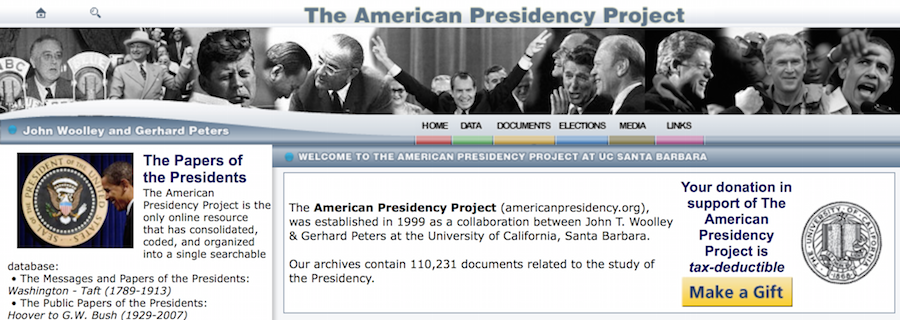Here's Where to Turn If You Have a Question About Presidents of the United States
Whenever an historian needs to verify information, or gather resources for research on a topic concerning our Commander-in-Chief, living and otherwise, there is only one place necessary to look: The American Presidency Project. Political debates will never be the same, with this tool at the fingertips of anyone with an Internet connection. With over 100,000 documents consolidated into one place, we may be looking at a more educated society, with a higher level of transparency within the realm of political debate. For Americans in the academic community and elsewhere, everybody is getting more excited about this project started by two UC Santa Barbara professors in 1999.
The American Presidency Project is headed up by professors Gerhart Peters and John T Woolley from UCSB, and they have been building their archive since 1999, with the goal to be the only online resource that has “consolidated, coded, and organized” thousands of documents related to the study of the presidency. 110,126 to be exact and the archive does not end with official statements by presidents during their time in office. It also contains thousands of other resources, such as party platforms, candidates’ remarks, statements of administration policy, documents from the Office of the Press Secretary, and election debates.
John T Woolley is a professor of Political Science at the University of California, Santa Barbara, and says that the major draw for people who use the American Presidency site is not just the size of the archive itself, but how easy it is to navigate and pull up information. “We know we are used by a wide variety of users – reporters, scholars, students, politicos, political junkies, curious individuals”, says Woolley. It would seem the American Presidency Project is a useful tool for anyone, and is a validation of the site creator’s success in building a site that is easy to use and full of information pertinent to the user’s interests.
Creating an archive of this size takes years, and seems to be a never-ending task. Some of the work of digitizing individual documents is already done for Woolley and Peters, other times they are forced to digitize a document for the first time on their own. “We have, somewhat reluctantly, digitized lots of documents. Years ago, we were actually the first on the web (we think) to have a complete set of State of the Union Messages because we digitized them ourselves. That unique status probably lasted for an hour. Many documents that have already been digitized have not been OCRd [optical character recognition]. A digitized image can be just fine for displaying on the web and be very inferior for OCR. In some parts of our collection, to really fill out the record in its entirety, we'll end up having to digitize things ourselves.”
Contributions and progress comes from different sources for the founders of The American Presidency Project, says Woolley, “within the past year we completed our collection of full text of Executive Orders back through the Truman administration. Until that point, nobody else on the web had that entire collection. Enthusiasts often share documents with us that they have and we do not. Recently somebody supplied us with a debate transcript we did not previously have.”
The only contributions they seem to lack are financial, although the APP has been praised by scholars everywhere, including Gil Troy, a Professor of History at McGill University and acclaimed author of several books, including his upcoming The Age of Clinton. “Believe it or not, we're still looking for sponsors to provide us with the kind of stream of financial support we need. If we had that financial support, we could devote more time to managing, updating, and enlivening the site…. Some things that seem obvious – like taking advertising--seem to be tricky for a University of California website.”
Gil Troy says the website has changed how he works. “The difference between researching presidential statements before the American Presidency Project and after is like the difference between the Pony Express and the telegraph – it's all about speed and efficiency. The three most amazing things for me about using the American Presidency Project in my research are first, it's comprehensive – it has EVERY public statement presidents have made, not some; second, the speed – the search engine is amazing, I can find a speech just based on a word fragment instantly; and finally, third, the extended intellectual range, rather than flipping through huge volumes of statements (I may not even have), I can make connections, within a particular presidency or throughout the history of the presidency.
“Added bonus: fewer footnotes in a book; in my latest books, I just tell the reader to search any statements in the Project, rather than having to detail each statement in the notes.”
The APP not only has the ability to serve historians, but the general public. A feature of the website catalogues newspaper endorsements for presidential candidates. In an article published on the Huffington Post, Professor Woolley believes these can be highly useful to voters. “I encourage you to actually read the endorsements, not just our APP tallies. At the APP, you can link directly to the editorials to benefit from their analysis.” It is clear from Woolley’s assertion that he would like to see the APP used by everyday Americans to make educated decisions on who they would like to vote for. “These data are a small part of the massive American Presidency Project (APP), at UCSB…. The current "smart" view of editorial endorsements is that they are an ineffectual relic of a bygone era. But I believe we should welcome and promote newspapers' editorial endorsements.”
With this tool available to the public and historians, the American Presidency Project is, in and of itself, historic in a way. The history of our presidency has never been so transparent or so dynamic.
